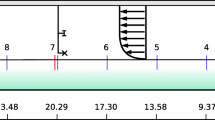Abstract
The development process of wind-waves of which spectral peak distributes from 0.6 cps to 9.3 cps will be discussed on the basis of the wind tunnel experiments and of the field observations performed at Lake Biwa. The characteristics of power and slope spectra are here presented. The development process of these wind-waves is characterized by three stages;i.e. “initial-wavelets”, “transition stage” and “sea-waves”. In the wind tunnel experiments, the transition from the stage of the “initial-wavelets” to the “transition stage” occurs when the wave spectral peak arrives at the line 6.40×10−4 k −2cm2·sec (wherek is wave number) or when the slope spectral density at the frequencyf max becomes larger than 6.40×10−4 sec. In the stage of sea-waves, the component wave of a wave-spectral peak is steepest in the component waves. And the wave spectral peak develops along the line 1.02×102 f −6 cm2·sec (wheref is the frequency corresponding to the wave numberk) untill it reaches the line 33.3f −4cm2·sec, and thereafter develops along the latter line, which indicates the constant density of slope spectrum. It is suggested that the nonlinearity of wind-waves must become stronger as wind-waves develop. The effective momentum fluxΤ ws from the air flow to wind-waves in this stage is evaluated to be about 4∼9% of the total stressΤ 0.
Similar content being viewed by others
References
Barnett, T. P. andJ. C. Wilkerson (1967): On the generation of ocean waves as inferred from the airborne radar measurements of fetch-limited spectra. J. Mar. Res.,25, 292–328.
Barnett, T. P. andA. J. Sutherland (1968): A note on an overshoot effect in wind-generated waves. J. Geophys. Res.,73, 6879–6885.
Barnett, T. P. (1968): On the generation, dissipation, and prediction of ocean wind waves. J. Geophys. Res.,73, 513–529.
Blackman, R. B. andJ. W. Tukey (1958): The measurement of power spectra. Dover Pub. Inc., New York, 1–82.
Burling, R. W. (1959): The spectrum of wave at short fetches. Dt. Hydro. Z.,12, 45–64 and 96–117.
Hamada, T., A. Shibayama andH. Kato (1963): An experimental study on development of wind waves. Port and Harbour Res. Inst., Japan, Report No. 2, 1–41.
Hamada, T., A. Shibayama andH. Kato (1966): A note on the development of wind waves in an experiment. Port and Harbour Res. Inst., Japan, Report No. 12, 16–29.
Hasselman, K. (1962): On the non-linear energy transfer in a gravity wave spectrum, Part I. J. Fluid Mech.,12, 481–500.
Hasselmann, K. (1963): On the non-linear energy transfer in a gravity wave spectrum, Part II. J. Fluid Mech.,15, 273–281.
Imasato, N. andH. Kunishi (1971): A note on the energy transfer from wind to waves. Contr. Geophys. Inst., Kyoto Univ.,11, 71–76.
Kinsman, B. (1965): Wind waves, Prentice-Hall, Inc., New Jersey, 543–583.
Korvin-Kroukovsky, B. V. (1965): Balance of energies in the development of sea waves, semi empirical evaluation. Dt. Hydro. Z.,18, 145–160.
Kunishi, H. (1963): An experimental study on the generation and growth of wind waves. Bull. Disast. Prev. Res. Inst., Kyoto Univ.,61, 1–41.
Kunishi, H. andN. Imasato (1966): On the growth of wind waves in high-speed wind flume. Annuals, Disast. Prev. Res. Inst., Kyoto Univ.,9, 667–676.
Mitsuyasu, H. (1968): On the growth of the spectrum of wind-generated waves (I). Report of Res. Inst. Appl. Mech., Kyushu Univ.,XVI, 55, 459–482.
Phillips, O. M. (1958): The equilibrium range in the spectrum of wind-generated waves. J. Fluid Mech.,4, 426–434.
Phillips, O. M. (1960): On the dynamics of unsteady gravity waves of finite amplitude, Part I. J. Fluid Mech.,9, 193–217.
Phillips, O. M. (1966): The dynamics of the upper ocean. Cambridge Univ. Press, London, pp. 113.
Plate, E. J. andG. M. Hidy (1967): Laboratory study of air flowing over a smooth surface into small water waves. J. Geophys. Res.,72, 4627–4642.
Plate, E. J., P. C. Chang andG.M. Hidy (1969): Experiments on the generation of small water waves by wind. J. Fluid Mech.,35, 625–656.
Stewart, R. W. (1961): The wave drag of wind over water. J. Fluid Mech.,10, 189–194.
Taira, K. (1972): A field study of the development of wind-waves, Part I. J. Oceanog. Soc., Japan,28, 187–202.
Toba, Y. (1973): Local balance in the air-sea boundary process III, On the spectrum of wind waves. J. Oceanog. Soc., Japan,29, 209–220.
Author information
Authors and Affiliations
Rights and permissions
About this article
Cite this article
Imasato, N. Some characteristics of the development process of the wind-wave spectrum. Journal of the Oceanographical Society of Japan 32, 21–32 (1976). https://doi.org/10.1007/BF02107653
Received:
Revised:
Issue Date:
DOI: https://doi.org/10.1007/BF02107653



